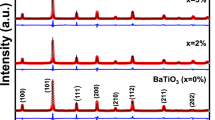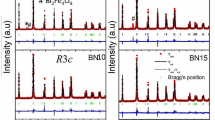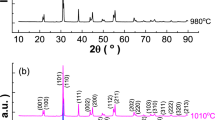New dielectric composite ceramics Na0.5Bi0.5TiO3–Ba(1–x)Sr x Ti0.995Zr0.005O3 (NBT–BSTZ) ( x= 0.05, 0.1, 0.2, 0.3) have been fabricated by the wet solid-state route. The effect of Sr content on phase structure and electrical properties has been studied in detail. The X-ray diffraction analysis illustrates that the composites consist of tetragonal perovskite. With increasing Sr content, the ceramic capacitors display larger dielectric constant, better temperature stability, and lower dielectric loss in dielectric behavior. The ceramics with composition x = 0.3 possess a large dielectric constant (εr) of 2522. The temperature coefficient of capacitance of NBT–BSTZ varies from –39% to 36% in the temperature range between 0 and 200°C. The dielectric loss of capacitance is below 0.07 while the Sr content is 0.3 in the whole range of measured temperatures. The results indicate that Sr-doping is an effective method to modulate the temperature stability and dielectric loss of the NBT– BSTZ dielectric ceramics.





Similar content being viewed by others
References
S. H. Kim and J. H. Koh, “The current relaxation behavior of Li doped 0.7(Ba,Sr)TiO3–0.3MgO thick film interdigitated capacitors,” J. Appl. Phys., 105, 061633 (2009).
J. G. Hao, B. Shen, J. W. Zhai, et al., “Switching of morphotropic phase boundary and large strain response in lead-free ternary (Na0.5Bi0.5)TiO3–(K0.5Bi0.5)TiO3–K0.5Na0.5)NbO3 system,” J. Appl. Phys., 113, 114106 (2013).
H. Takeda, W. Aoto, and T. Shiosaki, “BaTiO3–Bi1/2Na1/2TiO3 solid-solution semiconducting ceramics with T c >130°C,” Appl. Phys. Lett., 87, 102–104 (2005).
X. L. Wang and W. J. Cao, “Dielectric and ferroelectric properties of BaTiO3–(Na1/4Bi3/4)(Mg1/4Ti3/4)O3 ceramics,” Appl. Phys. Lett., 90, 042913 (2007).
Y. Terashi, A. Purwanto, W. N. Wang, et al., “Role of urea addition in the preparation of tetragonal BaTiO3 nanoparticles using flame-assisted spray pyrolysis,” J. Eur. Ceram. Soc., 28, 2573–2580 (2008).
P. S. Dobal, A. Dixit, R. S. Katiyar, et al., “Micro-Raman scattering and dielectric investigations of phase transition behavior in the BaTiO3–BaZrO3 system,” J. Appl. Phys., 89, 8085–8091(2001).
N. Ortega, A. Kumar, O. Resto, et al., “Compositional engineering of BaTiO3/(Ba,Sr)TiO3 ferroelectric superlattices,” J. Appl. Phys., 114, 104102 (2013).
W Li, Z. J. Xu, R. Q. Chu, et al., “Sol–gel synthesis and characterization of Ba(1–x)Sr x TO3 ceramics,” J. Alloys Compd., 499, 255–258 (2010).
T. Maiti, R. Guo, and A. S. Bhalla, “Structure–property phase diagram of BaZr x Ti1–xO3 system,” J. Am. Ceram. Soc., 91, 1769–1780 (2008).
Z. Yu, C. Ang, R. Y. Guo, and A. S. Bhalla, “Piezoelectric and strain properties of BaZr x Ti1–xO3 ceramics,” J. Appl. Phys., 92, 1489–1493 (2002).
E. Antonelli, R. S. Silva, and A. C. Hernandes, “Ba(Zr x Ti1–x)O3 (x=0.05 and 0.08) ceramics obtained from nanometric powders: ferroelectric and dielectric properties,” Ferroelectric, 334, 75–82 (2006).
L. M. Zheng, X. J. Yi, S. T. Zhang, et al., “Complete set of material constants of 0.95(Na0.5Bi0.5)TiO3–0.05BaTiO3 lead-free piezoelectric single crystal and the delineation of extrinsic contributions,” Appl. Phys. Lett., 103, 122905 (2013).
C. S. Chen, P. Y. Chen, and C. S. Tu, “Polar nanoregions and dielectric properties in high-strain lead-free 0.93Bi1/2Na1/2TiO3–0.07BaTiO3 piezoelectric single crystals,” J. Appl. Phys., 115, 014105 (2014).
S. Uddin, G. P. Zheng, Y. Iqbal, et al., “Unification of the negative electrocaloric effect in Bi1/2Na1/2TiO3–BaTiO3 solid solutions by Ba1/2Sr1/2TiO3 doping,” J. Appl. Phys., 114, 213519 (2013).
R. Garg, B. N. Rao, A. Senyshyn, and R. Ranjan, “Long ranged structural modulation in the premorphotropic phase boundary cubic-like state of the lead-free piezoelectric Bi1/2Na1/2TiO3–BaTiO3,” J. Appl. Phys., 114, 234102 (2013).
L. Dong, D. S. Stone, and R. S. Lakes, “Dielectric and viscoelastic properties of KNbO3 doped BaTiO3,” J. Appl. Phys., 109, 063531 (2011).
V. Krayzman, I. Levin, J. C. Woicik, and F. Bridges, “Correlated rattling-ion origins of dielectric properties in reentrant dipole glasses BaTiO3–BiScO3,” J. Appl. Phys., 107, 192903 (2015).
K. C. Verma, S. Singh, S. K. Tripathi, and R. K. Kotnala, “Multiferroic Ni0.6Zn0.4Fe2O4–BaTiO3 nanostructures: magnetoelectric coupling, dielectric, and fluorescence,” J. Appl. Phys., 116, 124103 (2014).
C. S. Tu, R. R. Chien, T. H. Wang, et al., “Dielectric response and origin in antiferromagnetic/ferroelectric (1–x)BiFeO3–(x)BaTiO3 ceramics,” J. Appl. Phys., 113, 17D908 (2013).
A. Feteira and D. C. Sinclair, “Average and local structure of (1–x)BaTiO3–xLaYO3 (0≤x≤0.50) ceramics,” J. Am. Ceram. Soc., 93, 4174–4181 (2010)
C. H. Yang, H. T. Sui, H. T. Wu, et al., “Enhanced ferroelectric and dielectric properties of Nb5+-doped Na0.5Bi0.5TiO3 thin film deposited under nitrogen annealing atmosphere,” Ceram. Int., 41, 10272–10275 (2015).
N. Lei, M. K. Zhu, P. Yang, et al., “Effect of lattice occupation behavior of Li+ cations on microstructure and electrical properties of Bi1/2Na1/2TiO3-based lead-free piezoceramics,” J. Appl. Phys., 109, 054102 (2011).
S. N. Tripathy, K. K. Mishra, S. Sen, and D. K. Pradhan, “Dielectric and Raman spectroscopic studies of Na0.5Bi0.5TiO3–BaSnO3 ferroelectric system,” J. Am. Ceram. Soc., 97, 1846–1854 (2014).
Y. P. Huang, L. H. Luo, J. Wang, et al., “The down-conversion and up-conversion photoluminescence properties of Na0.5Bi0.5TiO3:Yb3+/Pr3+ ceramics,” J. Appl. Phys., 118, 044101 (2015).
B. K. Barick, K. K. Mishra, A. K. Arora, et al., “Impedance and Raman spectroscopic studies of (Na0.5Bi0.5)TiO3,” J. Phys. D: Appl. Phys., 44, 355402 (2011).
Y. L. Ding, X. H. Zhang, C. H. Yang, et al., “Preparation and ferroelectric properties of lead-free A0.5B0.5O3 (A=Na OR K) thin films,” Surf. Rev. Lett., 18, 121–125 (2011).
E. Delgado, C. Ostos, M. L. Martínez-Sarrión, et al., “Characterization and electrical properties of new perovskite films of Ba(Ti,Zr)O3 type doped with lanthanum (BLZT),” Phys. Status Solidi C, 11, 4099–4106 (2007).
V. Buscaglia, M. T. Buscaglia, M. Viviani, et al., “Grain size and grain boundary-related effects on the properties of nanocrystalline barium titanate ceramics,” J. Eur. Ceram. Soc., 26, 2889–2898(2006).
A. Rajabtabar-Darvishi, R. Bayati, O. Sheikhnejad-Bishe, et al., “Giant dielectric response and low dielectric loss in Al2O3 grafted CaCu3Ti4O12 ceramics,” J. Appl. Phys., 117, 094103 (2015).
Acknowledgements
This work is funded by the National Natural Science Foundation of China (Grant Nos. 51302061 and 51308179), Natural Science Foundation of Hebei province (Grant Nos. E2014201076 and E2016201179), and Postgraduate’s Innovation Fund Project of Hebei University (Grant No. X2016084).
Author information
Authors and Affiliations
Corresponding author
Additional information
Published in Poroshkovaya Metallurgiya, Vol. 57, Nos. 1–2 (519), pp. 99–106, 2018.
Rights and permissions
About this article
Cite this article
Cheng, H., Song, A., Liang, M. et al. Dielectric Properties of Sr-Doped Na0.5Bi0.5TiO3–Ba(1–x)Sr x Ti0.995Zr0.005O3 Ceramics Synthesized by Wet Solid-State Method. Powder Metall Met Ceram 57, 75–81 (2018). https://doi.org/10.1007/s11106-018-9957-1
Received:
Published:
Issue Date:
DOI: https://doi.org/10.1007/s11106-018-9957-1




